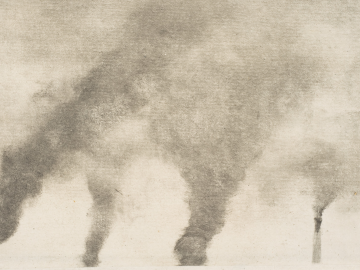Review of ‘The Living Sea of Waking Dreams’
Jessica White
Within the first few pages of Richard Flanagan’s The Living Sea of Waking Dreams, one encounters a raft of losses. The book, which centres around three siblings, Anna, Tommy and Terzo, and their mother Francie, opens with the vanishing of Anna’s middle finger; Tommy recounts the loss of ladybirds, soldier beetles, bluebottles, earwigs, Christmas beetles, flying ant swarms, frogs and cicadas and their songs, emperor gum moths, Persian rug wings, quolls, potoroos, pardalotes, swift parrots, great kelp forests, abalone, and crayfish; and it becomes known that there is a fourth sibling, Ronnie, who died in his teens.
Against this backdrop, in which bushfires rage from lightning strikes and the rainforests, ‘once wet mystical worlds, were now dry struggling woodlands, and the fires took, and the fires grew’, Francie begins to decline in a Hobart hospital. Describing herself as ‘the fittest old corpse in Christendom’ after surviving hydrocephalus (fluid on the brain) and non-Hodgkin lymphoma, she is diagnosed with a small brain haemorrhage. Tommy calls his brother and sister to her bedside. Over the course of the novel, Francie’s condition worsens, but Anna and Terzo fight both Tommy and the medical authorities to keep her alive.
Flanagan wrote this novel as the bushfires tore through trees, animals, houses and humans in the summer of 2019-2020. His opening pages, with death and disorder layered like thick paint, are an understandable response to the magnitude of ecological destruction. But if Flanagan wrote this book to articulate, as he writes, ‘the collapsing of the natural world’, his approach remains deeply and problematically anthropocentric. The book is fixated on its human protagonists and the drama of human death, underscoring the perspective that plant and animal deaths are less relevant – a perspective that has led to the diminishing of nonhuman life.
*
Anna, an architect, represents somnolent populations and politicians who do naught in the face of global heating and extinction. She registers her mother’s dying body — and Tommy’s messages about her decline — as an irritant. While Tommy thinks it best to let their mother die, Anna and Terzo are horrified at the thought. Francie remains in hospital, and when she asks her daughter to take her away so she can ‘die peacefully at her daughter’s home rather than live in torment in hospital’, Anna refuses, even though the refusal makes her feel ‘like a monster’. The pull and push of these discussions – her mother’s gentle imploring to die and Anna and Terzo’s refusal to allow her that wish – continue for the majority of the novel. The reader, too, is trapped by their decisions, and the low-level drama created by the human protagonists becomes tedious. Rather than engendering compassion, I found this construction tiresome: what could have been summed in a few paragraphs instead travels on for two hundred pages, flogging the proverbial dead horse.
On a more compelling note, the novel’s central conceit – the disappearance of Anna’s body – mirrors the vanishing of Australia’s species. Other parts of her body begin to disappear. Although her legs ‘had never been her best feature’ (Flanagan writes with a man’s eye, not a woman’s) she misses her knee once it disappears: ‘like the aurochs it was gone. Like the thylacine and the Walkman. Like long sentences. Like smoke-free summers. Gone, never to return.’
Where Anna’s response to the loss of her body parts and her mother is muted, Tommy’s reaction is intense. He observes that as the detritus of capitalism increases, and there were ‘more jackhammers more reversing trucks and falling and rising cherry pickers b-b-beeping, more tourist coaches clogging small streets more rolling suitcases click-clack-clacking in the street more Winnifuckingbagos more airbnfuckingbs more locals sleeping in tents all around the city until even his dreams filled with a nightmare of noise movement growth that seemed to benefit no one and only grew things that left people unsettled unhappy that made people poorer … there seemed less and less of the world maybe less and less of him’. Flanagan underscores how, in losing the natural world’s support structures, we will lose ourselves. He also shows the limits of the English language when it comes to describing the magnitude of extinction. Anna, looking at her missing hand, ‘had no words to describe, it no longer was.’
Perhaps this is why Flanagan turns to the figures of Tommy and his son Davy to articulate the cognitive dissonance of continuing life as usual as our ecosystems go into terminal decline. For a long time, Tommy has ‘been aware of a growing scream that was within him and outside him … He tried to contain that scream, it made him stutter, but it kept insisting.’ His son, Davy, is schizophrenic and is ‘tormented by voices, which is to say words’. In case Flanagan’s yoking of the death of the natural world and mental disorder is not clear enough, he drums it home with the gymnastics of Tommy’s voice:
The world grew daily hotter and smokier and nightly noisier: more construction noise more insects disappearing, more road noise more fish stocks collapsing, more news noise more frogs and snakes dying out, more brexittrump climatecoal more and more, more and more fucking tourists everywhere, even here at the end of the world, well they were queuing at the top of Everest what could you expect?
Anna regards Tommy with mild disgust, registering his ‘stammering way of speaking when he was nervous, one could say almost effeminate’ as a contrast to ‘Terzo’s strong voice making its simple declarations and giving its straightforward commands’. But the trope of Tommy’s stammer, which appears after Ronnie’s death following sexual abuse from the Marist brothers at his school, is barely sustained throughout the novel. Perhaps this is because much of it is recounted from Anna’s point of view; alternatively, once Tommy’s point has been made, his disability no longer matters.
Flanagan, in contrasting Tommy’s compassion with the lack of feeling from Terzo and Anna, suggests that it is only people with disability who can understand and respond to suffering. In reality, surviving in an ableist culture is so time-consuming that it leaves little left over to care for others. Likewise, he uses Davy as a mouthpiece for the madness of human existence in a decaying world. Anna pays Davy to care for her mother in the hospital, and compliments him on his sweetness with his grandmother. Davy smiles in response, and tells her ‘that he was used to people humouring him in his delusions. The problem, he said, was that the delusions were real.’ This exchange signals nothing of the difficulty of living with schizophrenia. Flanagan uses disability for symbolic capital, relying on cheap symbolism to express his ideas at the expense of realistic characterisation.
*
Flanagan’s descriptions of human suffering are a prominent feature of his fiction. His Booker prize-winning The Narrow Road to the Deep North features blow-by-blow accounts of the suffering of Australian prisoners-of-war in Burma. But as Australian plants and animals are left to go extinct through indifference and the charms of capitalism, do we need more stories of human misery? Is it not time to shift the lens and focus, as Flanagan finally does in the closing pages of The Living Sea of Waking Dreams, on something other than ourselves? Anna, at last reaching an epiphany of sorts about the cruelty of prolonging her mother’s life, joins a research project to find and count the orange-bellied parrot. When she disappears from life altogether, a paragraph reveals to the reader a ‘tiny bird, green as hope, newly arrived, two tiny black eyes brilliant as balls of dropped ink.’ The surrealism of these final pages thrums with life and magic, and in closing the book, one is left with a sense of missed opportunity. Rather than enlarging on the life of this little creature, it is instead overshadowed by the tedious recounting of self-involved children, on the pages of a novel as in real life.


